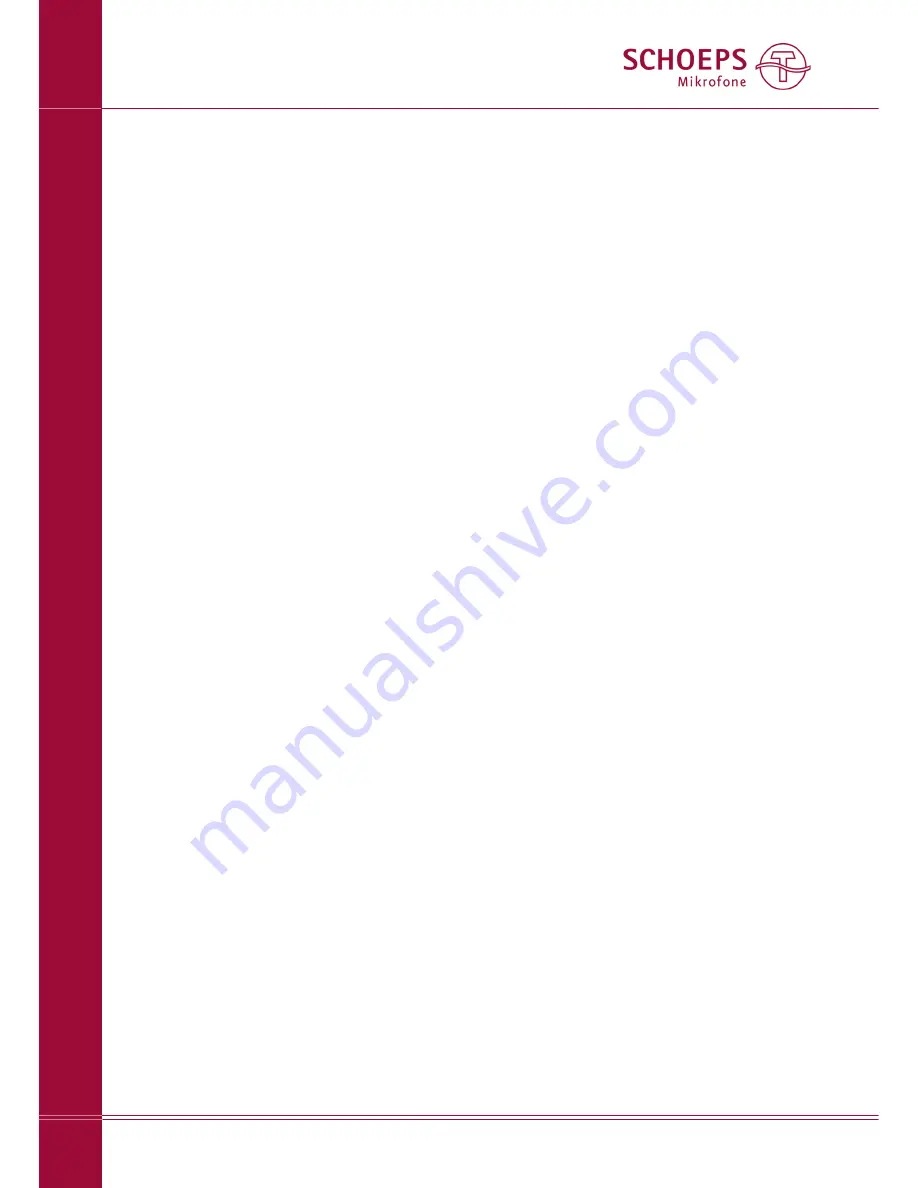
ground. This ”unbalancing act” must occur
between the power supply and the preampli-
fier input, however, since naturally all three
pins of the microphone must still connect to
its phantom or parallel power supply.
Simultaneous Connection to Multiple Inputs
If a microphone has to be connected to multi-
ple inputs simultaneously, an active micro phone
splitter should be used in order to preserve
the loading and powering conditions for the
microphone, and to prevent interference.
Maximum Cable Length
With the MSTC 64, cable lengths of several
hundred meters are possible. The practical
limit depends on the electrical capacitance of
the cable, which is sometimes an unknown
quantity. The lower this capacitance is per unit
length, the longer the cable can be. All
SCHOEPS
cables have very low capacitance
(100 pF/m between the conductors).
The main risks with excessively long micro-
phone cables are losses at high frequencies
due to cable capacitance, reduced ability to
handle very high sound pressure levels, and
increased likelihood of picking up interference.
Hints on Avoiding Interference
Due to the wide dynamic range of studio
microphones, the smallest signal amplitudes
are in the microvolt range (1/1,000,000 Volt).
Cable shielding and the grounding scheme of
the preamp or mixer input are also crucial.
A microphone can therefore never be expected
to be immune to all possible disturbances in
all circumstances, but the following suggestions
can help to reduce possible noise induction:
1) Keep both the microphone and the cable
away from sources of interference such as
monitors, digital equipment (computers), RF
emitters (mobile phones and other personal
communication devices that emit radio fre-
quency energy), power transformers, power
lines, SCR dimmers, switching power sup-
plies etc.
2) Use only high-quality cables with a high
degree of shield coverage.
3) Keep all cables as short as possible.
4) Dress audio cables away from power cables.
If they must cross, it should be at right angles.
5) At the preamp or mixer input, the shield of
the microphone cable should connect to
chassis ground in the shortest way possible.
If necessary, this coupling can be capacitive.
Wind Noise and Windscreens
Air motion (wind or air currents due to heat-
ing or air conditioning systems) can cause
noise that should always be dealt with. Even if
it doesn't cause overload, it will detract from
the clarity of sound. A wind or pop screen
should be used, but should be chosen carefully
to avoid changing the microphone's character-
istics too much. Many screen types which are
effective at reducing wind noise also have a
tendency to reduce a microphone's direction-
ality and/or its high-frequency response. Basket-
type windscreens are generally more effective
than foam-type windscreens when directional
capsules are being used, and their main side
effect is to create some unevenness in frequency
response (see our main catalog for details).
Vibration
If noise from mechanical vibration enters a
stand- or boom-mounted microphone, a shock
mount (elastic suspension) should be used, and
a loop of slack cable should be isolated and
tied off so that it does not become another
way for vibrations to reach the microphone.
Unlike a wind screen, a shock mount will not
affect the characteristics of a microphone. In
many kinds of work it is well justified to use a
shock mount ”by default.”
Overload
When dealing with problems of overload, it is
useful to think of your recording equipment
as a series of circuit stages. The goal is to find
the first stage that is being overloaded, and to
attenuate the signal at the input to that stage.
Reducing the gain at any earlier stage would
add unnecessary noise, while reducing it at a
SCHOEPS
GmbH · Spitalstr. 20 · D-76227 Karlsruhe (Durlach) · Tel: +49 721 943 20-0 · Fax: +49 721 943 2050
www.schoeps.de · [email protected]
Hints on Avoiding Interference
15
English




















